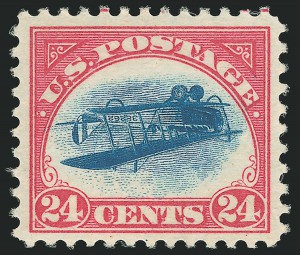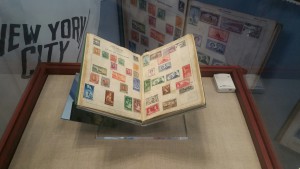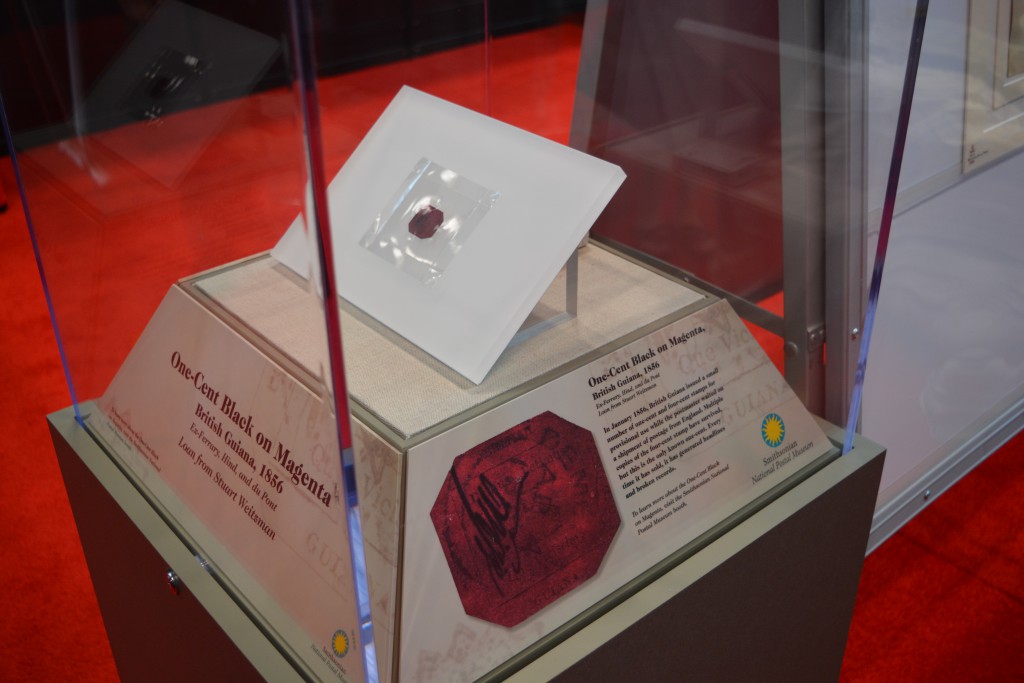The world’s most valuable stamp, the most famous U.S. stamp of all time and one of the world’s most popular stamp collectors are among the ‘must see’ displays of rarities at this week’s World Stamp Show in New York City.
As soon as spectators enter the Crystal Palace at the Javits Center, visitors see in person the real plane from the most famous U.S. stamp of all time, the Inverted Jenny. That’s the first rarity before even entering the massive hall, featuring the Court of Honor. Here, visitors view under tight security the famous British Guiana one-cent magenta and the boyhood stamp collection of John Lennon.

A restored, 100-year-old Curtiss JN-4H, dubbed the Jenny, is on display near the entry area of the World Stamp Show.
No doubt the most celebrated aircraft in all of philately, the Curtiss JN-4 (affectionately nicknamed the “Jenny,”) is the focus of what’s arguably the most famous U.S. stamp of all time, the Inverted Jenny (US Scott #C3a). Visitors can admire the restored, 100-year-old plane at close quarters in a special display area next to the show’s registration desk. The plane was reunited earlier this week with one of the inverted-centred stamps that secured its place in philatelic lore.
On Tuesday, Robert A. Siegel Auction Galleries offered the “highest-graded example to date from the original sheet of 100” Invert Jenny stamps. Within seven minutes of the bidding, the Invert Jenny was purchased by a private buyer for $1,175,000, plus the buyer’s premiums.
Scott Trepel, president Siegel Auction Galleries, told the New York Daily News: “We had a lot of action. And then it boiled down from $975K to $1,175,000. It was between the two contenders.”
While the identity of the new owner was not released, Trepel told the newspaper: “The buyer, he’s part of a history of owners, going back to back the original discovery. He joins a list of great collectors. Every time somebody has sold that stamp they have done very well.”
The story of the Jenny invert is one of the great tales of stamp collecting.

The highest graded Inverted Jenny, Position 58, sold on Tuesday for $1.175 US million, plus buyer’s premiums.
When the United States Postal Service decided to introduce regular air mail service in 1918 a new rate of 24-cent was set, much higher than the three-cent ground rate. A new stamp was rushed into production featuring an image of a Curtiss Jenny, the type of aircraft being used in the service.
The new stamp was printed in two colours, red and blue, a process which had led to error stamps in the past.
Collector William T. Robey, hoping to find just such an error, turned up at the post office on the first day of sale, May 13, 1919, and found a single sheet of 100 inverts, which he purchased.
The sheet was quickly sold to a dealer, and then to collector Col. H.R. Green, who broke up the sheet into one block of eight, several blocks of four, and a number of single stamps. Prior to breaking up the sheet, the dealer who managed the sale, Eugene Klein, pencilled the place position on the back of each stamp.
That sheet remains the only known example.
There’s always a guard standing close by, reminding visitors not to use their flash, when viewing and taking pictures of the famous British Guiana one-cent magenta, which was sold at auction a year ago for $9.48 million dollars to fashion shoe designer Stuart Weitzman.
In 1856, a shipment of postage stamps from Great Britain to the South American colony of British Guiana was delayed. The local postmaster, E.T.E. Dalton, ordered an emergency printing of stamps from local printers, Joseph Baum and William Dallas.
The design of a ship was selected from the printer’s inventory and three stamps were printed. The one-cent magenta, a four-cent magenta, and a four-cent blue. Reportedly, Dalton was not happy with the quality, and ordered that all copies be initialled by a postal clerk.
The one-cent stamp was for the newspaper rate, and only one example survived. It has the manuscript initials EDW, corresponding to postal clerk E.D. Wright, and it is postmarked Demerara.
The stamp itself was unknown for many years. In 1873 it was discovered by a 17-year-old stamp collector, Vernon Vaughn in his uncle’s old correspondence. Vaughn sold it to a local collector, N.R. McKinnon for six shillings. McKinnon sold it to a British stamp dealer, Thomas Ridpath who sold it to famous Austrian collector Count Phillip von Ferrary. When the count died in 1917 his famous stamp collection was donated to a German museum. At the end of the First World War, the collection was seized by France to be sold for war reparations. The collection was sold in a spectacular series of 14 auctions in 1922. Arthur Hind bought the one-cent magenta for $36,000 US. The stamp was offered for sale again by Harmer Rooke & Co., of New York, in 1935. The firm had it expertized by the Royal Philatelic Society, of London, that same year.
Hind’s widow, however, contested the sale, claiming that the stamp was not part of his estate, but had been gifted to her years before. She won the suit, and kept the stamp. In 1940 she offered it for sale through the stamp department of Macy’s store in New York City. Fred Small, an Australian engineer living in Florida, bought it for $40,000 US. Small sold his collection in 1970, and the stamp was acquired by a syndicate for $280,000. In 1980 it was sold to du Pont for $935,000 US. Du Pont, a member of the prominent family of chemical industrialists, was a somewhat unusual character. A philanthropist and a Harvard graduate with a PhD in ornithology, Du Pont kept the stamp, along with the rest of his British Guiana collection, in a bank vault.
Born in 1938 he conducted some research in the 1970s before settling down to a life of good works. He founded the Delaware Museum of Natural History, and supported the Eurasian Pacific Wildlife Conservation Foundation, and donated to several universities. He was married in 1983, but the marriage was annulled after 90 days. In the 1990s, du Pont became active in supporting amateur sport. He donated to several sports and opened up a training centre on his farm. He became a coach in wrestling, swimming, track, the modern pentathlon and started competitive wrestling. On Jan. 26, 1996, he shot and killed his friend, U.S. Olympic wrestler Dave Shultz in front of two witnesses. He was arrested after a two-day standoff. During his trial he entered a plea of not guilty by reason of insanity. A defence witness described him as a paranoid schizophrenic. Du Pont was found guilty of third degree murder and sentenced to 13 to 30 years in prison. He died in prison in 2010.
Within foot steps of this expensive stamp, is a display of stamps owned by one of the world’s most famous performers, John Lennon.

When the National Postal Museum first purchased Lennon’s “lost album,” late curator Wilson Hulme did note to Smithsonian Magazine that the collection did not boast any notable stamps. “Typically, young boys aren’t interested in rarity,” he said. “They tend to concentrate on geography and colors. If they come back to collecting when they have more time and money, that’s when collections become exceptional.”
The famous English singer and songwriter, who co-founded the Beatles, has his cousin Stanley Parkes to thank for piquing his interest in stamps. In a 2005 article in the Washington Post, Parkes, 72 at the time, recalled his famous cousin’s foray into stamps.
“When I was at home from school” in Liverpool, “he noticed I had this stamp album and I was collecting stamps, and he took an interest in it,” Parkes told the Post. “I said, ‘Well, John, the great thing about collecting stamps is that it helps with your geography. You see, the stamps come from all different countries, and you see the people on the stamps, and you take an interest in why the country exists,’ ” he said.
Parkes gave his “Mercury Stamp Album” to the young Lennon, who quickly rubbed out Parkes’ name on the album’s flyleaf and replaced it with his own.
Not surprisingly, Lennon, known as a budding artist at a young age, added his own touches to the album, drawing mustaches and whiskers in blue ink on the stamp likenesses of Queen Victoria and King George VI on the album’s title page.
The flyleaf page also contained handwritten notes by the young Lennon, including his name, address and how many stamps were in the album. His notations indicated 800 stamps at first, later crossed out and replaced with “675,” but the Smithsonian National Post Office Museum says it contained only 565 stamps when it acquired it in 2005. The album has 145 pages and features stamps from countries around the world, including India, the United States, and New Zealand.
Parkes recalled how Lennon persuaded his Aunt Mimi to give him the postage stamps from their relatives’ letters from New Zealand, and how he continued to collect and trade stamps for years after receiving the album.
Lennon’s circa 1950s album was purchased at auction for about $53,000 in June 2005 by the Smithsonian, and placed on display between Oct. 6, 2005 and April 10, 2006, to coincide with the 65th anniversary of his birthday.

